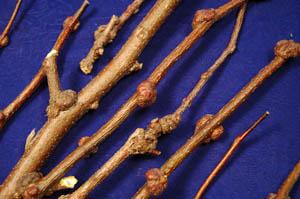Honeylocust Knot Again | |
|---|---|
| May 21, 2008 | |
|
We do not see this disease often in Illinois. In fact, I can only recall three cases at the Plant Clinic. The problem could prove to be more common, however, if allowed to spread nationally in the nursery industry. Honeylocust knot gets its name from the galls that form at branch or twig nodes, and sometimes between nodes. These galls are reported as 1/2 to 2 inches in diameter. On young twigs and in early stages, the galls start as two swellings at the node. Honeylocust knot is pictured here on some twigs that were recently brought to meby one of our Extension specialists.  Galls may girdle stems and cause death of tissue beyond the galls. Some nurseries have reported eventual decline and death of entire, infected trees. Pruning out the galls often results in spread of the problem. We do not know a great deal about this “disease.” The cause has not been identified. The disease is thought to be caused by a bacterium, but isolations and Koch’s postulates have not been successful for many reasons. Here is a brief synopsis of what we do know. Pierluigi Bonello and Maria Bellizzi, of the Ohio State University Department of Plant Pathology, reported honeylocust knot in 2000 from the Cincinnati, Ohio, area, as well as from a nursery in Michigan. In both cases, tree symptoms appeared again in 2001 and eventually led to tree mortality. The disease appeared in rows in the nursery and there was some thought that it might have been spread by hand pruning. By 2002, these researchers had reports of similar symptoms on honeylocust trees in Ohio, Illinois, Iowa, Kentucky, Maryland, and Michigan. The University of Illinois Plant Clinic has seen symptoms of honeylocust knot on trees in Cook County (2004) and Will County (2006). Researchers Bonello and Bellizzi put together a research report on this disease in 2002. You can view some images of the symptoms of the disease by visiting this site and clicking on the forward button to move through the sections of the report: http://ohioline.osu.edu/sc189/sc189_53.html. In 2005, Michigan department of agriculture inspectors found honeylocust knot on nursery trees shipped from Minnesota. Those trees were destroyed. We had not heard of any further work on this problem for the last few years. Recently, however, we learned that an assistant professor and graduate student in plant aathology at the Ohio State University are beginning a new project involving this problem. We will keep you posted on any new developments. | |
| Author: | Nancy Pataky |
